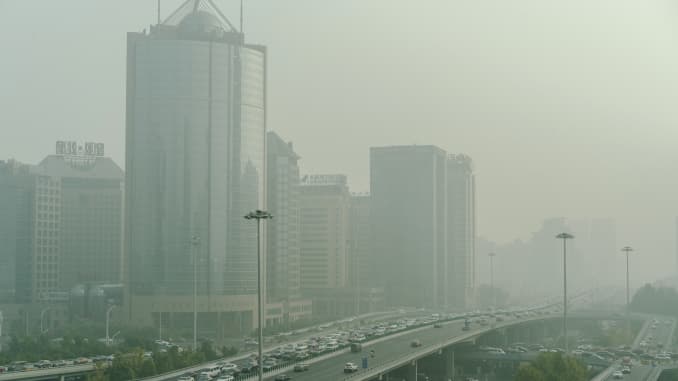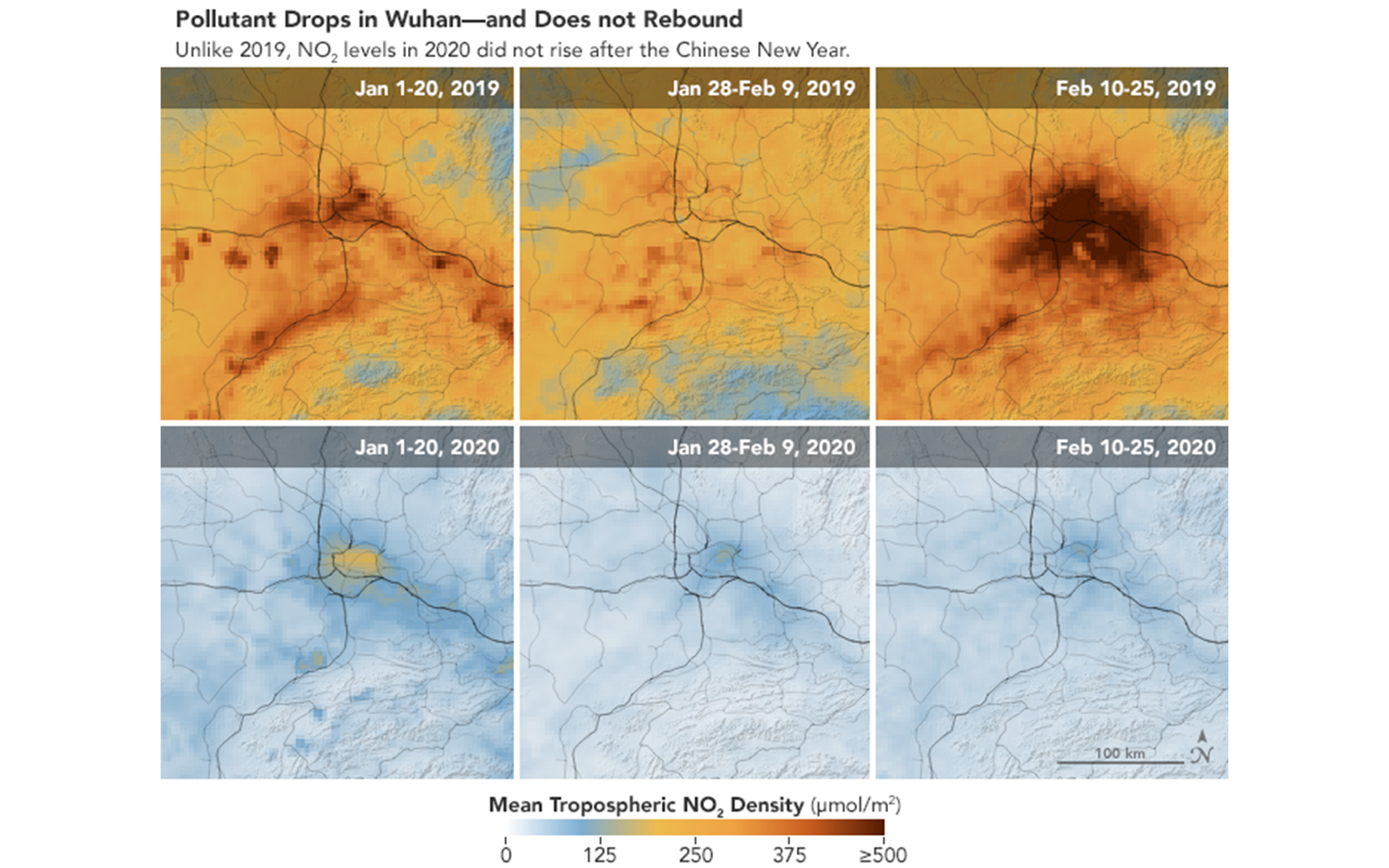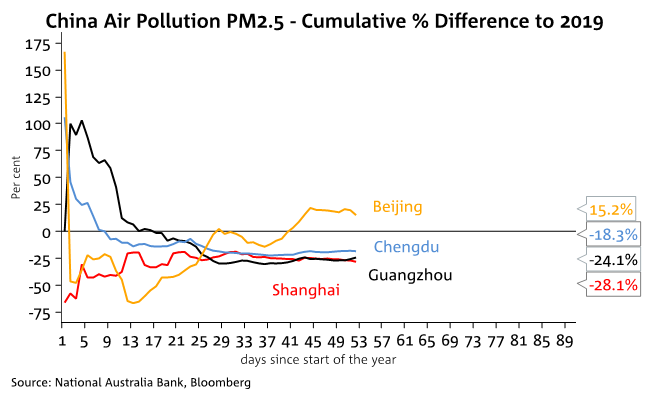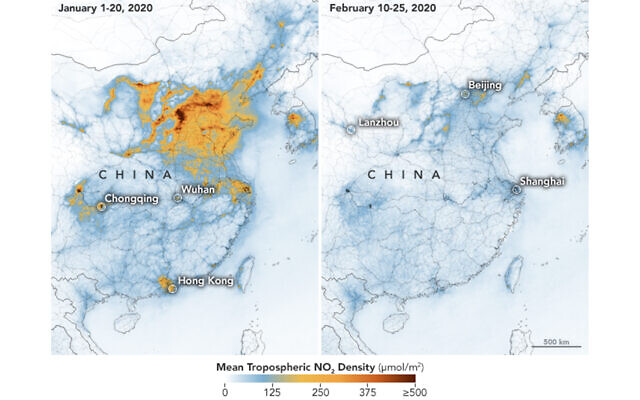China’s recent air pollution levels may be telling a story about the coronavirus impact on its economy
KEY POINTS
- Analysts are using pollution levels as a gauge of industrial activity. Major cities in China are well known for being choked by smog, due to the extensive burning of coal by factories.
- On Feb. 20, daily coal consumption of six major power plants was 42.5% less than the same period last year, according to Japanese bank Nomura, which has been tracking such metrics daily.
- “The weak resumption of production is reinforced by a set of high-frequency indicators in the areas of energy consumption, real estate transactions, passenger traffic, and air quality,” J.P. Morgan wrote.

Office buildings amid the heavy haze at Beijing’s business district, in a photo from 2017.
Zhang Peng | Contributor
All eyes are on China’s progress in getting its factories to crank up again, after the country extended this year’s Lunar New Year holiday and shut down major growth regions in a bid to contain the coronavirus outbreak.
Many of its provinces started gradually limping back to some form of production last week, about two weeks later than previous years.
The Chinese government has also been giving regular updates, reporting last Wednesday that work resumption rate has topped 50% for some industrial companies in key economic regions such as Guangdong and Shanghai.
WATCH NOW
Chinese state media also reported Tuesday that more than 80% of its central state-owned companies’ roughly 20,000 manufacturing subsidiaries have resumed work.
But here’s how some economists and analysts are tracking the story of China’s progress in returning to work — as the world’s second largest economy gears up to return to full production.
Air pollution levels, coal consumption
Analysts are using pollution levels as a gauge of industrial activity. Major cities in China are well known for being choked by smog, due to the extensive burning of coal by factories.
So far this year, pollution levels have been between 20% and 25% lower compared to the same period last year, Tapas Strickland of National Australia Bank (NAB) said in a note earlier last week, suggesting there was a substantial decline in industrial activity in the first quarter.
Referring to the official update that more than 80% of China’s 20,000 manufacturing subsidies have resumed work, Rodrigo Catril, senior foreign exchange strategist at NAB, cast doubt on the actual progress.
“This news should have been embraced warmly by the market, however high frequency data such as pollution levels and traffic congestion gauges in Beijing do not at this stage corroborate the upbeat official message, keeping investors wary,” he said in a note Wednesday.
On Feb. 20 (Thursday), daily coal consumption of six major power plants was 42.5% less than the same time last year, according to Nomura, which has been tracking such metrics daily. The Japanese bank has also been following data on traffic congestion, passenger flows and new home sales in a bid to track the progress of China’s work resumption.
“The pace was slow due to a lack of workers and strict reopening criteria, and it varied across cities, industries, and firms,” J.P. Morgan’s Sin Beng Ong wrote in a note last week.
“The weak resumption of production is reinforced by a set of high-frequency indicators in the areas of energy consumption, real estate transactions, passenger traffic, and air quality,” he said.
Passenger migration across China
Other metrics — such as traffic congestion and passenger numbers — could also shed some clues on the full picture of China’s return to work.
Analysts typically look at the Baidu Migration Index, which tracks the number of workers returning from their hometowns to work after the Lunar New Year (LNY) holiday.
“The Baidu migration index suggests that only 37% and 33% of people that left tier-1 and key tier-2 cities for LNY have returned (vs. 100% at this point last year),” Morgan Stanley analysts wrote last week. large
According to Nomura, the worker return rate for 15 cities was 25.6% as of Feb. 19, only around a quarter of what was recorded a year ago.
However, Oxford Economics pointed out in a note on Thursday that such gauges do not completely reflect the full back-to-work progress, as they don’t take into account the practice of working from home amid the virus crisis.
“Pollution and traffic volume statistics provide one guide to the speed at which China is returning to business as usual,” the advisory firm said.
“But they’re imprecise indicators of activity growth and will fail to fully capture shifts in spending and activity (e.g., greater online spending and remote working),” it said, adding that the first gauge will “come from the business surveys of sentiment.”

Pollution levels plummet over China following coronavirus quarantine
Satellite imagery from NASA shows steep drop in noxious gas over central, eastern areas of country, as government forces closure of factories, transportation
China has seen a drastic decrease in pollution since the coronavirus epidemic emerged there in December, according to satellite images by NASA and the European Space Agency.
The maps released by the agencies on Sunday shows levels of nitrogen dioxide in the air over eastern China before and after a government imposed quarantine over large areas of the country in late January.
Nitrogen dioxide is a noxious gas produced by vehicles, power plants and industry. It can cause or exacerbate respiratory problems, including asthma.
The gas levels decreased drastically after the quarantine started, starting in Wuhan, where the virus first emerged, then spreading outward, NASA scientists said.
Wuhan, which has 11 million residents, was put on lockdown, with transport links in and out of the city closed off. The city’s Hubei province, home to some 40 million, was also largely isolated from the rest of the world. Factories and other workplaces in the industrial region were temporarily closed.
“This is the first time I have seen such a dramatic drop-off over such a wide area for a specific event,” said Fei Liu, an air quality researcher at NASA’s Goddard Space Flight Center.
Air pollution levels generally drop during the Lunar New Year holiday as businesses and factories close in late January and early February, but the amount of nitrogen dioxide in the air this year was much lower than in previous years, and has remained lower since the holiday’s end.

Satellite imagery compares pollution over Wuhan, China, during the same periods in 2019 and 2020. (NASA Earth Observatory/Joshua Stevens)
The researchers said they saw a drop in the pollutant during the economic recession in 2008, but the decrease came more slowly.
Since the start of 2020, including before the quarantine, nitrogen dioxide levels were 10 to 30 percent lower in eastern and central China than in previous years.
The images were produced using data collected by monitoring instruments on the European Space Agency’s Sentinel-5 satellite and NASA’s Aura satellite.
The novel coronavirus has infected some 89,000 people globally and killed 3,000 in over 60 countries, with the vast majority of cases in mainland China. Israel has confirmed 12 cases and no deaths.



No comments:
Post a Comment
Comments always welcome!